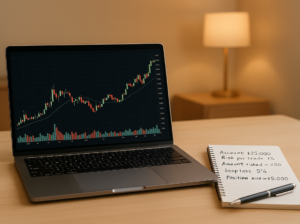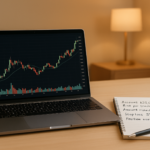5 Types of Investor Biases That Can Stop You From Making BIG Profits!
How many times have you looked back on your trade and went something like “What was I thinking?!”
Well this happens to the best of us, it just seems to happen more frequently in trading because we receive very clear feedback from the decisions we made. (ie. either you make money or your don’t.)
Our decision making happens as a response to a perceived situation.
The key word to note here is “perceived”. This is because there are almost always two or more ways to look at any circumstance. And how you look at the circumstance, will determine the action you take.
For example, a baby bird learning to fly falls to the ground. To the mother bird, it’s a bad thing, she has to try to bring her baby to safety as soon as possible. To a cat however, this is a good thing, she has an easy meal for today.
As traders and investors, perception of a any situation is very important in driving our actions in response to this.
So one of the most common things which affect our perception of an event, is called a “Bias”.
By being aware that such biases exist and how they affect our perception, we can better mitigate their effects and give us a more objective view of a situation.
In our case, our view of the market and what it is trying to do.
#1 Anchoring Bias
This is one of the most common biases. Have you ever sat on a losing trade, which has not reached your stoploss order yet but there you are, hoping and wishing that price would come back and let you get out at breakeven?
That’s an anchoring bias.
We anchored our decision to the entry price of our trade.
But in reality, the market has no idea our entry is there, nor does it have any inclination to let us out at breakeven. That market will go where it wants to go.
The moment you can accept this, the next time you perceive that the market is no longer willing to move in your trade direction, you will automatically exit at whatever best price you can even if it’s at a small or moderate loss.
#2 Confirmation Bias
A confirmation bias is sort of us getting blinded by a view. We only accept information which reinforces our view of the market, but we ignore any thing we is against our view.
So it is important to be open to new information and give it the thought it deserves.
There may be times when the new information can be discounted, and that’s fine.
With experience and more solid trade analysis rules, we will be able to counter this bias.
3) Escalation Of Commitment
I’m sure many of you have heard of people, who bought a stock as a short term trade. Then the next time you see them a year later, they have became “investors” of that stock, with plans to pass it their grandchildren.
Sound familiar?
That’s an escalation of commitment bias, because they have been involved with the position for too long, refusing to cut loss or take profits. (Highly likely refusing to cut loss)
This is one of the reasons traders should include a time-stop in their trading plans.
It will save you and your capital from being locked up in a trade.
#4 Availability Bias
This bias describes judging a situation using only information which is quickly and easily available to us.
The fact is, this is hasty decision making.
We should do our due diligence with any trade idea we observe, not just make a hasty decision based on what we already know or whatever is on the headlines at the time.
Take time to question and explore, eventually we will find out what works for us.
#5 Hindsight Bias
When new traders try to develop their own strategy, this is one of the first biases which will hit them. Possibly the most likely reason why whatever strategy they develop, will not work in live trading.
Hindsight bias is the false belief that we could have accurately predict the outcome of a past event.
I’m sure you have heard of all these “would have, should have, could haves” when talking to your friends about their trading experiences.
Don’t fall into this hindsight trap!
Personally, I do not mind these words, but it must be said in a context of learning, and not a regretful story-telling context.
Look back on the past within the framework of your strategy or analysis. If in your journals, you are able to pick out a specific factor which consistently gives you an edge. Then do your research and backtesting, put it into your trading plan if there is evidence that it gives your trading an edge.
Keep your eyes and mind open, good trading everyone!















